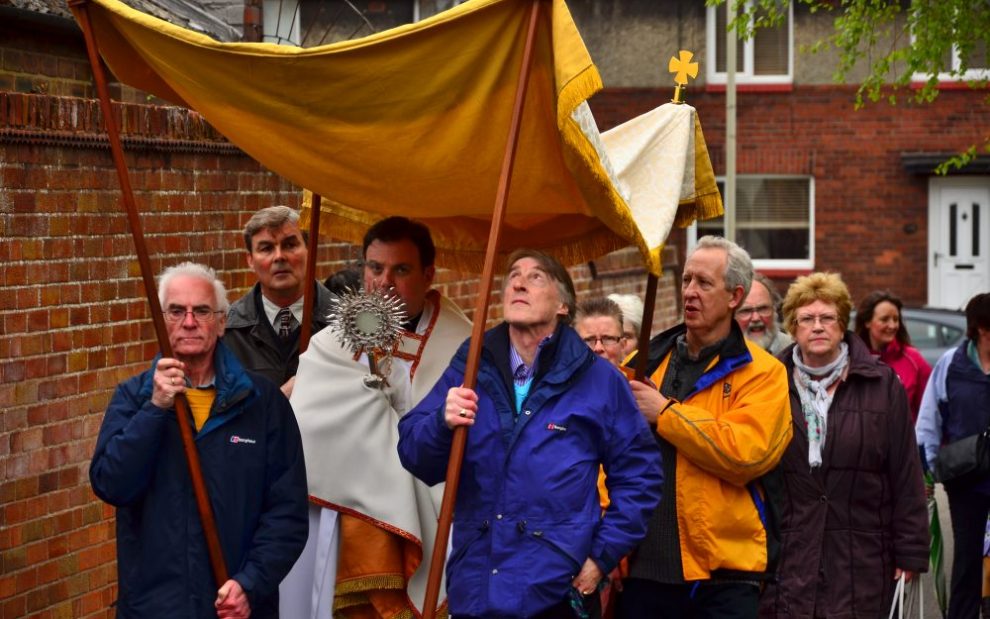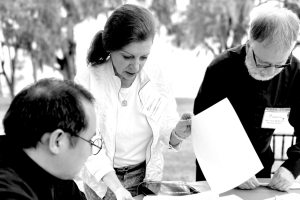Is the Eucharist working? It may seem a strange question, but it’s one that is worth asking, especially this year, the Year of the Eucharist in the Catholic Church.
Some have been claiming for a long time that the Eucharist is not working because of published reports that most Catholics no longer believe the bread and wine really become the Body and Blood, soul and divinity of Jesus Christ.
Critics point to the absence of “eucharistic piety” they observe among Mass-goers: failure to genuflect when entering or leaving the church, the routine way people come up to receive Communion, the casual conversations right in front of the tabernacle after Mass. And so the church has undertaken a worldwide effort this year to educate Catholics about the nature of the Eucharist and to promote devotions such as visits to the Blessed Sacrament, Benediction, perpetual adoration, even public eucharistic processions and rallies.
Others see the issue differently. That some Catholics fail to believe Christ is truly present in the form of bread and wine is lamentable, they agree. But even more lamentable, they insist, is that great numbers of Catholics, including many whose devotion to the Eucharist is rock solid, fail to grasp the intimate connection between the Eucharist and justice, between Christ present in the bread and wine and what we do or don’t do in the world around us.
Dangerous disconnect
Almost 25 years ago the late liturgist Father Robert Hovda put it this way: “Our habits and our predetermined ways and the structures of our society have fastened such blinders on our harnesses that, as a whole, Christians and Christian churches in our society have only the haziest notion of any moral imperative flowing from the Sunday meeting in which we celebrate God’s word of human liberation and solidarity and then act it out in the breaking of the bread and the sharing of the cup. As obvious as those ethical demands are, they simply do not impinge, they do not get through to us. We are too well protected by the world we live in.”
Hovda said the Eucharist isn’t working as it should because it has been “domesticated.” He cited the anguished words of a Sri Lankan bishop, who wrote: “Why is it that in spite of hundreds of thousands of eucharistic celebrations Christians continue as selfish as before? Why is the gap of income, wealth, knowledge, and power growing in the world today-and that in favor of the Christian peoples? Why is it that persons who proclaim eucharistic love and sharing deprive the poor of the world of food, capital, employment, even land?”
The Eucharist, whether seen as Holy Communion or as the Mass, can become “a kind of product created for individual spiritual customers,” says Gabe Huck, a veteran liturgist and former director of Liturgy Training Publications. “It’s supposed to have a transforming effect on us,” he says, “so that we leave church determined to do something. We should be seeing the world in a different way and have different priorities because of the Eucharist. It should affect what we do with our time, how we spend our money, how we look for a job, how we vote.”
This message of a transformative connection between Eucharist and responsibility to the world may be communicated at many parishes in only the vaguest way. In others, however, where a concerted effort is made, the message is getting through.
Practice what they preach
It is impossible to attend a liturgy at Good Shepherd Parish in Menomonee Falls, Wisconsin without seeing the connection. Prominently hanging in the church are seven banners representing basic principles of Catholic social teaching, such as the option for the poor and vulnerable, the call to community, the dignity of work, the rights of workers, and care for creation.
The banners are just one manifestation of a five-year “Destination Justice” program the parish is currently committed to. Other activities include monthly social justice e-mails to update some 300 interested parishioners on subjects such as just war theory, fair housing, or the land mine crisis in Asian countries. Adult learning experiences place parishioners in 11-week programs with organizations working with the poor, the homeless, and those in prison. Skits performed before Sunday Mass alert churchgoers to a range of human concerns.
The mandate for all this appears near the top of the Good Shepherd website: “We believe that a commitment to social justice is as much a part of being Catholic as the Eucharist is, and we think it’s time to bring involvement in social justice back to the center of parish life.” The pastor, Father Kenneth Mich, says the parish, which was founded 48 years ago and numbers about 1,000 families, has a longstanding commitment to service.
“We don’t look at Eucharist as just Jesus’ Body and Blood,” he says. “We see it in the context Jesus placed it in at the Last Supper. He was really saying, ‘This is my body broken for you, this is my blood poured out for the world.’ And when he said, ‘Do this in memory of me,’ he was telling us, ‘Now go break your body and shed your blood in the service of others.'”
That hard message, recapitulated in homilies and given visibility in outreach programs for the poor, disturbs some parishioners, Mich admits. “Some would prefer a docile, consoling Eucharist,” he says, “so this can be a challenging place.”
Jane Clare Ishiguro, the pastoral associate, notes that parishioners are “all over the map” in their degree of commitment to the Good Shepherd vision. But “we all get along,” she adds, “because everyone sees a church that acts more than it talks.”
Money where their mouth is
In Arvada, Colorado, a suburb of Denver, Spirit of Christ Catholic Community makes the connection in several dramatic ways. First, parishioners are informed that it is a “stewardship community,” which means 14 percent off the top of the Sunday collections goes to the poor and needy. And at this parish of about 3,300 mostly upper-middle-class families, 14 percent amounts to about $300,000 a year.
Kathi Palitano, director of pastoral ministry, says recent recipients include groups digging wells in Nicaragua, providing care for AIDS orphans in Africa, and serving the homeless in the Arvada area. “It’s a demanding process for us and the applicants,” she says, “but it ensures the funds are going to responsible people.”
Second, the parish has a “Southern Exposure” program, which so far has involved 40 groups of parishioners in constructing from scratch 150 homes in poverty-stricken areas of Mexico.
Third, some 800 parishioners participate in 80 small faith groups that discuss how the Sunday lectionary readings relate to their life in the world. Then there are the 400 persons involved in liturgical and other ministries, says Janette Fayhoe, liturgy director. And the parish’s adult education forum brings in high-caliber guest speakers like Sister Helen Prejean and Bishop Thomas Gumbleton.
This intense activity is successful, says the pastor, Father Robert Kinkel, because “everything we do is presented as flowing directly from the Eucharist; the connection is in the homilies, the intercessions, the music.”
What helps make it all come together, he adds, is the location of the altar-right in the midst of the assembly. “Everyone can see what we have here,” he says, “the Body of Christ celebrating the Body of Christ.”
Beyond Jesus-and-me
At Our Lady of the Most Holy Rosary in Albuquerque, New Mexico, the pieces are also in place. The pews are in a horseshoe shape around the altar “so the visibility is wonderful and there’s no last row where people can hide,” says the Norbertine pastor, Father Joel Garner. In addition, this parish of 2,500 families has “the best and most active” St. Vincent DePaul Society in the region, a commitment to small faith communities, and a determination to link the Eucharist to the larger world.
The parishioners, about 85 percent of whom are later-generation Americans of Mexican descent, are attracted to an older, more devotional Catholicism. The church has overnight adoration of the Blessed Sacrament once a month. “That sometimes is where their energy goes-that and the veneration of the saints. This is what the people were taught to do,” says Garner. The result, he says, can be a Jesus-and-me spirituality that he does not want to stifle, yet he and the staff hope to open it to wider horizons.
One strategy the staff has developed is a vigorous welcoming approach designed to push people beyond personal concerns and into the wider community. The most visible sign of this is the requirement that before Mass eucharistic ministers stand at the doors and welcome churchgoers with smiles and handshakes. “A lot of newcomers are not used to such greetings,” says Christina Spahn, pastoral associate for faith formation, “but they come to appreciate it.”
Consciousness-raising is also evident in the Pax Christi group now in formation; in the Mass intercessions, which relate to needs in and well beyond the parish; and in the parish’s 12-year relationship with Albuquerque Interfaith, which promotes grassroots conversations and cooperative action in the city.
True authenticity
Parishes like these are attempting to put into practice what Vatican II’s Constitution on the Sacred Liturgy called for: “full, conscious, and active participation in the liturgy,” since it is “the indispensable source of the Christian spirit.” A booklet on the Year of the Eucharist published by the U.S. Conference of Catholic Bishops highlights the social dimensions of the Eucharist, citing the late Pope John Paul II’s declaration that the Eucharist fosters “a social love in which we put the common good ahead of private food, take up the cause of the community, the parish, the universal church, and extend our charity to the whole world.”
In his apostolic letter inaugurating the eucharistic year, John Paul was even more pointed: “We mustn’t deceive ourselves; it’s from our reciprocal love and, in particular, from the concern we have for those in need that we will be recognized as true disciples of Christ. This is the criterion on the basis of which the authenticity of the eucharistic celebrations will be confirmed.”
As several commentators quickly noted, use of the word “authenticity” with regard to the Eucharist almost always refers to carrying out the proper liturgical regulations. Yet here is John Paul asserting that, even if all the liturgical protocols have been satisfied, the Eucharist is not “authentic” unless it is related to those in need.
This emphasis is greatly diminished in a major document coming from the Vatican this year and in some Catholic publications, which tend to concentrate on Eucharist as exclusively an object of adoration.
Father Keith Pecklers, a professor of liturgy at the Pontifical Gregorian University in Rome, says many liturgists regard the document proposed for discussion at the Synod of Bishops meeting in Rome in October as “discouraging, one-sided, and totally inadequate.” Titled The Eucharist: Source and Summit of the Life and Mission of the Church, this 17,000-word preparatory statement has sections on the history, theology, and spirituality of the Real Presence, but its discussion of liturgy and mission is preoccupied with ceremonial propriety. The section on the Mass ends abruptly with the Communion of the faithful and the hope that “the mystery, celebrated and received, may be fruitful.”
Pecklers fears the impression may be given that the Mass exists solely to obtain the Blessed Sacrament. “There seems to be an overemphasis on adoration versus service and a mostly individualistic link between the believer and Jesus,” he says.
Lost in all this, he adds, is the emphasis the early church placed on Eucharist as holy bread and holy drink, especially St. Augustine’s insistence that Christians partake of Christ’s Body in order to become Christ’s Body in the world. Also lost in the document, he says, is the intimate connection between eucharistic authenticity and service. Only a few lines near the conclusion do the words “a commitment to the poor” appear for the first time.
A host of problems
Meanwhile, many diocesan newspapers are promoting Eucharistic adoration as never before, with feature articles in every issue and lists of all parishes that offer the devotion, with days and times. One diocesan editor called private adoration “my favorite time of the day and week,” and a bishop in his weekly column said Eucharist takes believers “out of time” and “into the future.” Serra International is sponsoring a tour of the United States this year with a special monstrance blessed and used by Pope John Paul II.
Much of this attention may stem from the shock waves still coming from a 1994 New York Times survey of Catholic belief. One question asked, “Which of the following comes closest to what you believe takes place at Mass: 1) The bread and wine are changed into the Body and Blood of Christ, or 2) The bread and wine are symbolic reminders of Christ?”
Some 63 percent of Catholic respondents chose option 2, calling the Eucharist “symbolic reminders,” while a mere 34 percent chose “changed into the Body and Blood.” For those between 18 and 29 years of age the disparity was even greater, with 70 percent preferring “symbolic reminders.”
Although the pollsters acknowledged that the question was posed awkwardly (since both answers could be interpreted as partially expressing Catholic doctrine), the message that went out through the media was: “Catholics don’t believe in the Eucharist anymore, and it’s even worse among the young!”
Other surveys since, using better-worded questions, report 80 percent or more of Catholics holding a more acceptable formulation, but a kind of international panic has lingered among many U.S. bishops and church officials in Rome. The heavy campaign zeroing in exclusively on Eucharist as Jesus’ Body and Blood can thus be seen as a somewhat belated attempt to remedy the perceived crisis.
A sure bet
In some areas of the United States the needs of the larger community are so obvious that the leap from Eucharist to service comes almost spontaneously. Such is the case in Las Vegas. The city may be most famous for its casinos, which foster illusions of wealth, and its glitzy nightlife, but there’s a downside to all the hype. Las Vegas draws people from all over the country, some hoping to get rich quick, others certain they’ll find high-paying jobs; many end up penniless, homeless, and jobless.
Because of this unrelenting need, Christ the King, a parish of some 3,000 upper-middle-class residents, has become a kind of full-time Catholic Charities center and a destination point for the desperate.
“Somehow they find us,” says Jane Fransioli, parish outreach coordinator, “and they just keep coming.”
Fransioli oversees dozens of teams of parishioner volunteers who serve two shifts a day, five days a week, handing out sandwiches, food stamps, gas money, and clothing, taking calls and making referrals to hospitals and social service agencies.
“The need is so great, there’s no way the city can handle it,” she says. “The variety we get is amazing-people whose car has broken down who have no way to get back home, a whole family that had been living in a sewer pipe, a woman whose husband is dying in a motel. It never ends.”
“The connection to service is just inescapable here,” says Mary Jane Leslie, liturgy director. “It’s perfectly clear to everyone that we gather on Sunday to hear the Word, share the bread, and then go out to do.”
The message is appropriately illustrated through the Sunday collection, 10 percent of which is immediately set aside for outreach. There is no standard taking-up of the collection; everyone in church proceeds up to the altar in the center of the church with their offering; often they are asked to bring certain foods that are in short supply to place in baskets near the altar, perhaps tuna fish at the 9:30 Mass, peanut butter and jelly at the 10:30.
The message is also visually communicated through a large, triptych sculpture on the patio near the church entrance. In the center panel it portrays Jesus riding into Jerusalem on a donkey, and in the outer panels are the poor and sick and the downcast he came to serve.
“You can’t go either in or out of this church without being confronted by this magnificent piece of art,” says Father William Kenny, the pastor.
“The people get it”
At St. Pius V in Chicago it is the experiences of the parishioners themselves that make obvious the link between Eucharist and action. St. Pius is an overflowing, 4,000-member congregation composed of poor, mostly immigrant Mexican Americans. And while remnants of Spanish devotionalism linger, the general response to the prophetic message of scripture comes quite naturally to these people, says Dominican Father Charles Dahm, the pastor.
“It’s not hard at all for them to identify with Jesus, who was unjustly treated and executed,” he notes. “Discrimination and marginality in the gospel readings resonate with people who regularly have harsh experiences with landlords and store owners and the public schools and the police.” The parish sponsors a soup kitchen, a secondhand store, a counseling center, and a grammar school.
Dahm uses the Sunday preaching as a major vehicle for connecting the Eucharist with life. “I’m always finding ways to incorporate a social justice message,” he says, “and believe me, the people get it. I say things that would cause people to walk out of church if I said them in River Forest [an upscale Chicago suburb].”
In his recent book, Parish Ministry in a Hispanic Community (Paulist), Dahm writes, “Because the Word of God is alive and must touch the contemporary world, parish preaching must include not only personal challenges like forgiveness, anger, and resentment but also current events and social issues.”
Congregational singing is another vehicle at St. Pius. The parish staff has incorporated rhythms from Latin America and lyrics with a biblical perspective that reflect working-class struggles. Now, says Dahm, many who attend St. Pius, although they live long distances from the parish, say, “The music keeps us coming.”
You are what you eat
The predominantly African American parishioners are also the link in two churches in inner-city New Orleans. At both Our Lady Star of the Sea and St. Philip the Apostle, the communities are bedeviled by gang activity, unemployment, and joblessness.
“So when they hear that the Son of Man had nowhere to lay his head,” says Father R. Tony Ricard, pastor of both parishes, “they know what that means. A lot of them have been evicted from their homes a time or two themselves. They know suffering just as Jesus did.”
Ricard says his churches sponsor exposition of the Blessed Sacrament only one day a year, Holy Thursday, because he wants people to realize they are the tabernacles of the Eucharist. That’s what he preaches in and out of season: “If you are what you eat, and if you receive the Eucharist over and over for years, then just about every cell in your body has been nourished with it. That’s who you are! You bring Jesus’ body and blood out into the world.”
Ricard is also striving to bring the world, especially young people, to the Eucharist. Besides the usual variety of sports and other youth activities, Ricard draws substantial numbers of teens directly into liturgical participation.
“On Youth Sunday,” he says, “we might have 70 or 80 up around the altar-there’s the youth choir and the junior ushers and the ministers of hospitality and the readers and the dancers (we call them the movement team), and maybe eight or more servers.” When the young participate, he believes, they’re inclined to take more seriously what the church is all about, and so are their parents and other relatives.
Following up on this activity, Ricard and his staff recruit parishioners young and old for community ministries, including neighborhood cleanup and efforts to demand accountability from local elected leaders and city officials. Participation in liturgy and creating a better world are part of the same thing, he says, “and our people know it.”
Making a difference
So is the Eucharist working? It is in parishes like these where strong preaching and liturgy, genuine outreach, and a welcoming community are important values. And they are not alone.
It happens at Holy Trinity in Washington, where justice-oriented preaching and a multi-service outreach packs the Masses every Sunday. More than half the worshipers are coming from Arlington, Virginia, outside the Washington archdiocese.
It happens at parishes like St. Nicholas in Evanston, Illinois, where Massgoers, gathered all around the altar, speak of the profound, often moving sense of community they feel. Says parishioner Joe Boyle, “When the priest lifts up the consecrated bread and wine, I see these holy things amid the faces on the other side of the altar, and it’s like I’m linked with all of them and we’re all being lifted up.”
It occurs in an area of rural Minnesota near Murdock, where five small parishes that were clustered together 24 years ago have developed a sense of community, sharing, and concern for the larger world that surpasses anything that existed when each was independent.
And the Eucharist is working in St. James Cathedral in Seattle, Washington, where the words “I am in your midst as one who serves” appear around a beautiful skylight high over the altar. “I had always thought of liturgy as a place where I could hide and recover from my difficulties,” says Bill McJohn, a computer programmer. “But after I moved here and heard the preaching and saw what was going on, like the ministry to the homeless, I finally got it. The liturgy feeds us in order to do the work God sets before us.”
Image: Flickr/Moreno Berti [CC BY-ND 2.0]












Add comment